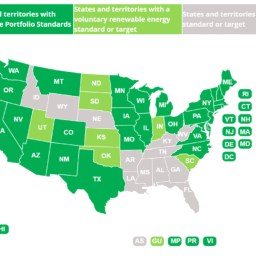 2020 was a year that disrupted industries across the global economy, and the energy sector was no exception. The COVID-19 pandemic caused dramatic shifts in the energy sector, from sharply decreased oil demand to drastic increases in residential energy usage, as people stayed home with limited travel for both work and leisure. Although 2020 presented many challenges, it resulted in an excellent year for renewable energy and sustainable transportation. Renewable energy sources produced more electricity in the US than coal for a record 40 straight days in 2020, and global EV sales grew 43% year over year. Here are five key energy industry trends from 2020 that we believe will have continued momentum and importance in 2021.
2020 was a year that disrupted industries across the global economy, and the energy sector was no exception. The COVID-19 pandemic caused dramatic shifts in the energy sector, from sharply decreased oil demand to drastic increases in residential energy usage, as people stayed home with limited travel for both work and leisure. Although 2020 presented many challenges, it resulted in an excellent year for renewable energy and sustainable transportation. Renewable energy sources produced more electricity in the US than coal for a record 40 straight days in 2020, and global EV sales grew 43% year over year. Here are five key energy industry trends from 2020 that we believe will have continued momentum and importance in 2021.
Continued Growth of Community Solar and Virtual Net Metering:
Until recently, potential commercial and residential solar customers would have to purchase modules to place on their home or business if they wanted to access renewable energy. The continued adoption of community solar and virtual net metering has allowed a collection of customers to participate in a portion of a large scale community solar project. Potential customers are no longer limited to those owning homes or buildings with ample roof or land space to accommodate solar. Similarly, virtual power purchase agreements have become a common way for corporations to build out large scale solar projects in remote locations to hit their sustainability goals, procuring electricity that their on-site infrastructure couldn’t support.
As of December 2020, twenty US states plus Washington DC have official community solar legislation in place. Solar customers in these states are no longer limited to their available rooftop space or the length of their lease agreement. As states and federal agencies look to facilitate solar access to a more diverse range of buyers, community solar and other off-site energy generation will need to play an increasing role. With the unique financing structures of community solar and virtual PPAs, the residential and commercial solar industry will see a more diverse collection of stakeholders benefitting from renewable energy.
Expanding Electrification of the Transportation Sector:
2020 was a remarkable year for electric vehicles. While you may have noticed more Model 3s quietly zipping around your neighborhood lately, you may not have seen other macro-trends that will allow EV adoption to continue to expand in 2021. In particular, the timing and location of EV charging is a massive challenge that needs to be solved going forward. With its’ Charge NY program, states like New York realize that significant expansion of charging infrastructure will lead to higher adoption of EVs and lower carbon emissions from transportation. 2021 has already seen positive momentum on this front, with Colorado utility company Xcel Energy approving a $110 million plan to build 20,000 charging stations across the state. Ultimately, EVs can prove to be a significant revenue source for electric utilities as customers switch from fueling vehicles at a gas station to powering their electric cars at home or a remote charging station. With additional utilities planning for this mostly untapped revenue source, we expect to see the launch of similar programs across the country.
Electrification of transportation has extended far beyond people purchasing Teslas for their daily drivers. The pandemic has driven a greater demand than ever for overland shipping and delivery services, and with it, an increased need for electric trucks, buses, and vans. Amazon has unveiled its’ new delivery van and expects to have 10,000 of them on the road by 2022. Shipping companies like FedEx, UPS, and J.B. Hunt have acknowledged the need for sustainable transportation and have committed to electrifying their fleets with purchases of Tesla’s new semi-truck. For the non-driving city dwellers, your daily commute may soon be powered by electricity as well, as municipalities like NYC partner with ProTerra, an electric bus company. With transportation being the largest emitter of C02 out of any US industry, we will need continued innovation and adaptation in the electric vehicle space through 2021 and beyond.
Increasing Importance of Energy Storage
 Since the inception of the renewable energy industry, energy storage has been a challenge. Storing energy economically to keep the lights on when the sun goes down has always been a prominent issue standing in the way of solar becoming a larger portion of the nation’s electric generation capacity. Until recently, there have been few viable solutions to address this challenge that renewable energy presents. 2020 has seen innovations in the utility, commercial, and residential energy storage segments that promise to address this vital issue with storing renewable energy long term. Q3 of 2020 saw the largest quarter of energy storage installations on record, with 476 MW installed in the quarter, and an expected year over year growth of 240% after counting the final 2020 installation numbers.
Since the inception of the renewable energy industry, energy storage has been a challenge. Storing energy economically to keep the lights on when the sun goes down has always been a prominent issue standing in the way of solar becoming a larger portion of the nation’s electric generation capacity. Until recently, there have been few viable solutions to address this challenge that renewable energy presents. 2020 has seen innovations in the utility, commercial, and residential energy storage segments that promise to address this vital issue with storing renewable energy long term. Q3 of 2020 saw the largest quarter of energy storage installations on record, with 476 MW installed in the quarter, and an expected year over year growth of 240% after counting the final 2020 installation numbers.
Corporate Shift to Solar PPAs in Place of Cash Purchases
The pandemic caused significant disruptions to corporations of all sizes in 2020 and will likely continue to do so in 2021. For many of them, merely staying afloat took priority over pushing forward renewable energy projects that they’d been considering. Power purchase agreements provided a unique opportunity for companies to realize the long-term savings and benefits of going solar without making large upfront investments. Companies favored preserving capital for other essential operations while simultaneously cutting energy costs via solar PPAs. Additionally, in a tough financial year for most companies, PPAs remove concerns about the tax appetite needed to monetize the investment tax credit.
This financing structure has allowed corporations to expand renewable energy procurement by 45% in 2020 to a total of 8GW of installed capacity, despite all the challenges posed by the pandemic. Even corporations that had historically been less than champions of renewable energy, like oil giant Chevron, realized the benefits of solar PPAs as they announced a 500MW solar energy procurement to power operations across the globe. As we move through 2021, we look for corporations to increasingly take advantage of solar PPAs to meet their sustainability goals while cutting their operating costs.
Continued Push for Pro Renewable Legislation
The biggest energy policy story of 2020 came at the end of the year when Congress passed the spending bill, including an extension of the 26% solar tax credit, additional funding for clean energy research and development, and the opening of federal lands for renewable development. Until the passing of this last spending bill, there wasn’t much in the way of federal renewable energy policy in recent years. States, utilities, and corporations took it upon themselves in 2020 to expand renewable energy goals and support favorable policy. Thirty-seven states have passed renewable portfolio standards, requiring minimum percentages generation of the state’s electric capacity to come from renewable sources. One of the most aggressive state renewable goals was set by Virginia in 2020, which requires 100% of utility electricity to come from renewable sources by 2050. Major corporations have also used their influence to drive renewables forward, as companies like Google pledged to run carbon-free for all operations by 2030. Many states with existing renewable portfolio standards have recently upped their goals to run on 100% renewable energy, with 17 states having some form to 100% renewable commitment for their electrical generation.
 Still, for 2021 we look forward to more favorable policies coming from the federal level. A sizeable federal infrastructure push is an initiative with bipartisan support and could be one of the most significant drivers of renewables in the future. Electrical grid transmission issues have often been a hindrance to renewable energy installation. An extensive infrastructure push to upgrade America’s transmission system and modernize the electric grid will expand hosting capacity for renewable energy and storage. An infrastructure bill could also provide tremendous opportunities for electric vehicle charging, as the government looks to ensure fast and readily available charging is in place for the transportation industry’s future. Expect President Biden to move towards a more pro-renewable stance from day 1 of his presidency. He has committed the US to rejoining the Paris Climate Agreement, positioning his administration and the US towards a cleaner energy future.
Still, for 2021 we look forward to more favorable policies coming from the federal level. A sizeable federal infrastructure push is an initiative with bipartisan support and could be one of the most significant drivers of renewables in the future. Electrical grid transmission issues have often been a hindrance to renewable energy installation. An extensive infrastructure push to upgrade America’s transmission system and modernize the electric grid will expand hosting capacity for renewable energy and storage. An infrastructure bill could also provide tremendous opportunities for electric vehicle charging, as the government looks to ensure fast and readily available charging is in place for the transportation industry’s future. Expect President Biden to move towards a more pro-renewable stance from day 1 of his presidency. He has committed the US to rejoining the Paris Climate Agreement, positioning his administration and the US towards a cleaner energy future.
Despite all of the challenges 2020 has presented, the transition towards renewable energy and clean transportation has persisted. As the world looks to normalize in 2021, expect this transition to accelerate even further. Positive project economics and favorable federal policy will be a crucial tailwind driving the industry forward through this year and beyond.




